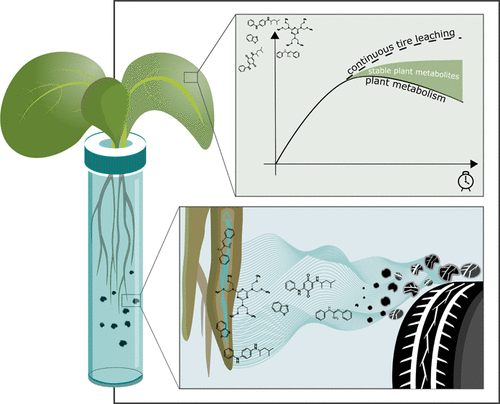Title: Uptake, Metabolism, and Accumulation of Tire Wear Particle-Derived Compounds in Lettuce
Authors: Stephanie Castan, Anya Sherman, Ruoting Peng, Michael T. Zumstein, Wolfgang Wanek, Thorsten Hüffer, Thilo Hofmann
Journal: Environmental Science and Technology
Year: 2023
Featured image by Castan et al. Environ. Sci. Technol. 2023, 57, 168-178.
—
You can’t have a salad without lettuce—the base that carries delicious dressings, crunchy croutons, and tasty toppings. But recently, scientists have found that lettuce leaves could be a vehicle for something much more sinister: pollutants from worn-down tires.
Tire wear is inevitable. Since braking relies on friction between the road and your tires, the tires will slowly break down, releasing nearly 6 million tons of tire wear products (TWPs) into the environment every year, consisting of rubber particles, fillers, and plasticizers. These nasty byproducts can make their way into farmland soil in runoff water, through atmospheric deposition, or from fertilizer derived from wastewater.
TWPs can be harmful if we ingest them when we eat plants like lettuce. But even more concerning is that plants can metabolize TWPs and transform them into new compounds. We don’t yet know what these transformation products might be, how toxic they are, or how long they stick around in the plant. This knowledge gap may lead us to underestimate the amount of TWP transformation products we’re consuming and how much risk they pose.
In 2022, scientists at the University of Vienna studied the fates of five types of TWPs and their transformation products formed in lettuce plants. They added solutions of each TWP to the lettuce plants’ nutrient solutions, and they harvested the plants at intervals ranging from 2 hours to 14 days after exposure. The researchers determined the amount of TWP that accumulated in the leaves and roots by homogenizing the plant tissues, extracting the TWPs with acetonitrile, and measuring their concentrations using ultra-performance liquid chromatography/mass spectrometry. Figure 1A shows the concentration of each TWP accrued over time after the initial addition of TWPs.

Figure 1. Concentrations of TWPs in lettuce leaves over 14 days after a) a single addition of TWPs to the plants’ water or b) continuous leaching of TWPs into the water. (Source: Castan et al. Environ. Sci. Technol. 2023, 57, 168-178.)
The team found all five TWPs in the roots and leaves of the lettuce plants. Three of the five TWPs showed the highest concentrations after 7-10 days, while one peaked in concentration after 6 hours and one increased in concentration continuously over the full 14 days. In particular, one TWP known as HMMM (a molecule that connects long rubber chains and improves tire elasticity) appeared at much higher concentrations than the others—20 micrograms of HMMM were present per gram of lettuce biomass. That may not sound like a lot, but at that concentration, an average head of romaine lettuce would contain 10-15 mg of HMMM—equivalent to a few crumbs of the rubber used in astroturf football fields.
The team also looked for compounds that might form when TWPs get metabolized. Using mass spectrometry, the researchers identified 19 possible transformation products that could be formed from the five parent TWPs. As the concentrations of the parent TWPs in the leaves began to decline, the concentrations of the transformation products increased. Some of the transformation products also appeared to be more stable than the parent TWPs, continuously accumulating in lettuce leaves over the full 14 days. Their results suggest that the transformation products can stick around long after the parent TWPs have gone.
Finally, the team showed that when the lettuce plants were grown in water containing continuously replenished TWPs, the plants kept taking in TWPs from the water as they metabolized the parent TWPs into more stable products. Figure 1B shows the concentration of each of the five parent TWPs in lettuce leaves grown for 14 days in water containing TWPs. That continuous uptake could pose a problem if TWPs are regularly introduced to farmland soil.
These findings could influence regulatory efforts on TWP concentrations in plants. The current regulations, which only account for the presence and concentration of the parent TWPs, might be underestimating the extent to which potentially harmful TWP transformation products remain in our food.
Though there are still several unanswered questions to explore, like how soil microbes can affect TWP concentrations and how humans react to the transformation products of TWPs, this work lays the foundations for further study of how TWPs and other pollutants accumulate in plants and offers an approach to identifying possible TWP transformation products. Precisely regulating contaminants in plants will help create safer and healthier food for all of us.

